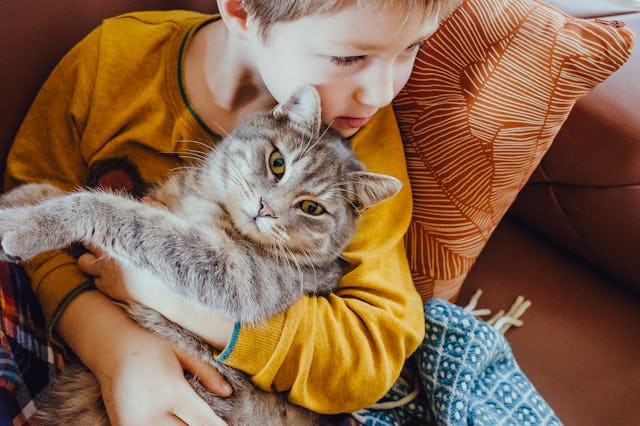Why Is Our Cat Shedding So Much? What’s Normal — & How To Minimize The Mess
A veterinarian has the advice you need when it seems like the family cat’s hair is everywhere.

You love the family cat, but let's be honest — you could do without all the cat shedding. When you have guests over, you've taken to giving the old "sorry for the cat hair!" disclaimer. It's not uncommon for your kids to find an errant cat hair (or two) in their dinner. And you've bought so many lint rollers at this point that you could hand them out as party favors. But while it's normal to be a little tired of finding fur all over the house, it's also normal for your cat to shed.
"Shedding fur is a normal cat characteristic and is a part of the normal healthy cycle of hair growth; it helps get rid of dead hairs and encourage healthy oils on the skin," Dr. Megan McCarthy, a veterinarian at Best Friends Animal Society, tells Scary Mommy. "Hairs go through full growth cycles, which includes shedding once the hair is at the end of its cycle. Changes in weather and seasons can also cause cats to shed their fur — for example, most cats shed heavily in the spring and fall."
If you're struggling to manage your cat's shedding, below are some tips to stay on top of those fur tumbleweeds. Plus: insight on why your cat sheds and how to tell if they need medical attention.
Good Basic Grooming Tips for Cats
To start, some basic grooming might help keep your cat's shedding under control. You may have noticed that your little fur ball is an expert at grooming itself and doesn't require baths (except for the Sphinx), but sometimes they need a little assistance from their humans.
"In general, for brushing your cats and cleaning its ears and trimming nails, I always recommend positive reinforcement to make it a good experience," McCarthy says. "A lot of cats do not like restraint or handling, and providing a high reward treat like a small amount of canned food, tuna, or Churu squeeze treats, can make the cat more comfortable and apt to remain still for grooming."
Generally, says McCarthy, brushing fur several times a week, trimming nails once every 2-4 weeks, and cleaning ears once every four weeks is sufficient for most cats.
How to Reduce Cat Shedding
Technically, you can't really "reduce" cat shedding so much as you can manage it. And according to McCarthy, the best way to help manage cats shedding is routine brushing using a soft rubber brush or a fine tooth metal comb, which can help get rid of excess hair that is ready to be shed. How much your cat will regularly shed can also depend on your cat’s breed, so keep that in mind.
"I recommend brushing at least several times per week, and possibly daily brushing for cats with medium or long hair, as they have higher grooming needs. Routine brushing also helps avoid problems like hair matting and knots," she says. It might be rough-going until your cat adapts to the routine, but brushing your cat can help minimize the cat hair you find around your home.
McCarthy also notes that your cat’s diet can play a significant role in your their coat health, explaining, "Adding a fatty acid supplement like fish oil or salmon oil that contains Omega-3s and Omega-6s can also help with skin and coat health to help manage shedding.
Ensuring your cat is properly hydrated and drinking water is another good tip to keep your cat's coat as healthy as possible. Dehydration not only affects the functioning of the kidneys and other vital organs of the body, but it can also lead to extra shedding. To help keep your cat hydrated, you can add some water to their dry kibble, add some wet food to their diet, and/or consider using a water fountain for their water intake, as cats are fascinated by running water.
When Shedding Might Be a Medical Issue
Do you often find yourself wondering, “Why is my cat shedding so much?” Sometimes your cat's shedding and grooming could indicate a larger medical issue. Potential causes of problematic or excessive cat shedding may include:
- Anxiety, fear, or stress
- Allergies
- Malnutrition or other nutritional issues
- External parasites
- Hormonal imbalances
- Physical condition that makes grooming themselves difficult
- Other underlying medical conditions
- Behavioral issues
"Signs of a medical issue include bald patches or excessive grooming (pulling out chunks of fur, causing wounds and sores)," McCarthy says. "Lesions to watch for include skin redness, scabs, crusts, and baldness."
As always, when in doubt, give your veterinarian a shout.